if the universe were contracting what would happen to light from other galaxies as it reaches earth
Activity Notes
- See tips for remote educational activity in the Management section.
Overview
In this activity, students will learn almost the expanding universe and the redshift of lightwaves. They will then summate the redshift of a supernova, make up one's mind its velocity relative to World, and find the distance to that object.
Materials
Management
- Students should have a general agreement of the electromagnetic spectrum and/or wave properties (i.east., amplitude, wavelength, frequency, and speed).
Tips for Remote Instruction
- Use an overhead camera to show students the stretching elastic demo. Place a ruler parallel to the elastic so students tin encounter the numeric change in distance betwixt moving ridge crests.
Background
Understanding redshift
Our eyes can but see a pocket-sized portion of the electromagnetic spectrum – the portion nosotros telephone call visible lite. Other portions of the spectrum accept wavelengths too long or too short for our eyes to perceive.
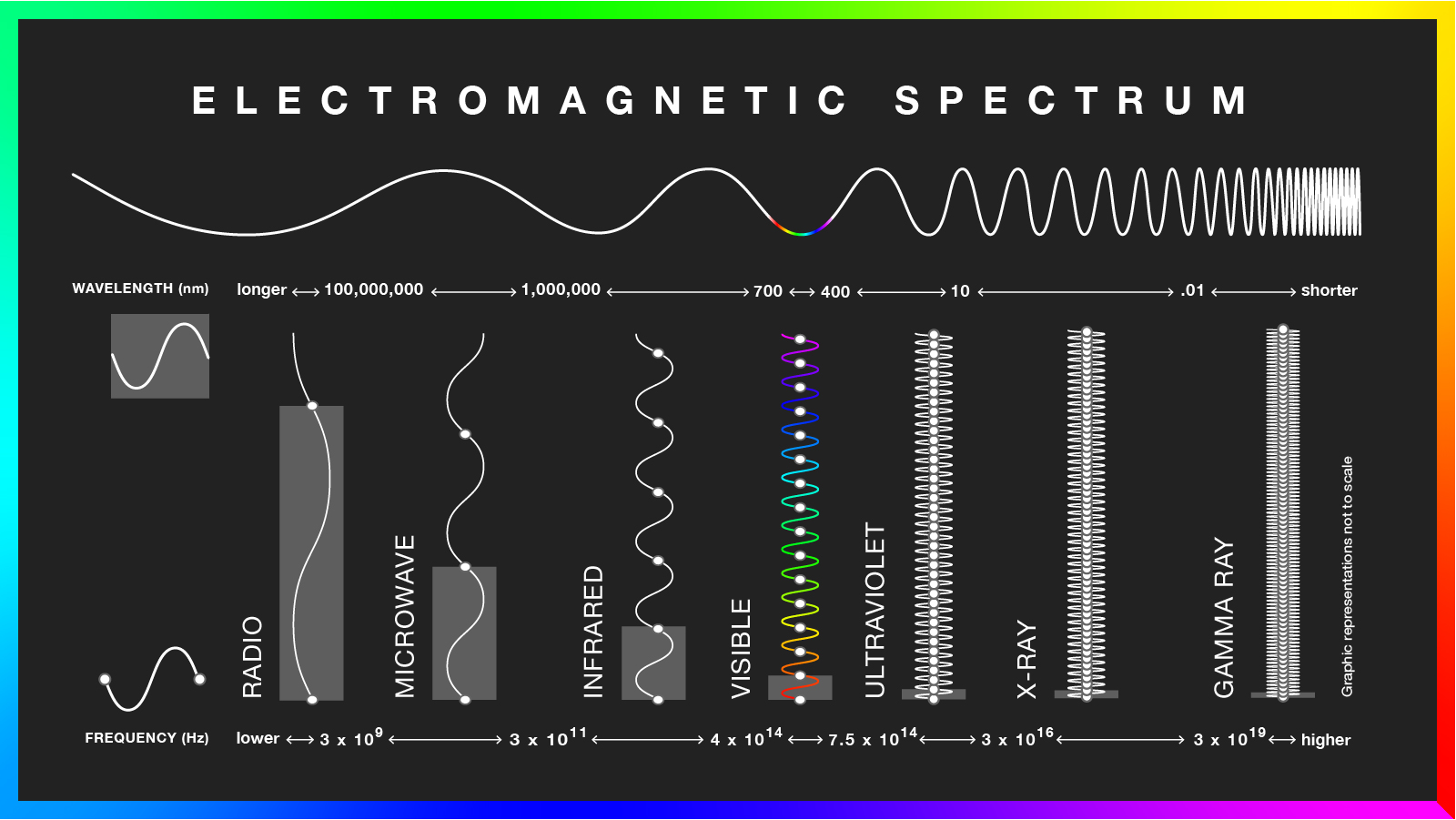
Visible light, the type of calorie-free humans can perceive with their eyes, is merely i tiny piece of the electromagnetic spectrum. This chart compares the wavelength and frequency range of each kind of wave on the electromagnetic spectrum. Note: The graphic representations are not to scale. Epitome credit: NASA/JPL-Caltech | + Aggrandize image | › Download low-ink version for printing
Typically, the human eye can find wavelengths from 380 to 700 nanometers (nm). For comparison, a human hair is most eighty,000 nm wide. Equally the full spectrum of visible light travels through a prism, the wavelengths split into the colors of the rainbow because each color is a different wavelength, thus refracting, or angle, a different amount. Violet has the shortest wavelength at effectually 380 nanometers and red has the longest wavelength at around 700 nanometers.
Every type of atom or molecule gives off energy at specific wavelengths. For instance, hydrogen atoms emit visible calorie-free at 410.ii nm, 434.0 nm, 486.ane nm, and 656.iii nm. This predictable blueprint of emitted light is called an emission spectrum.
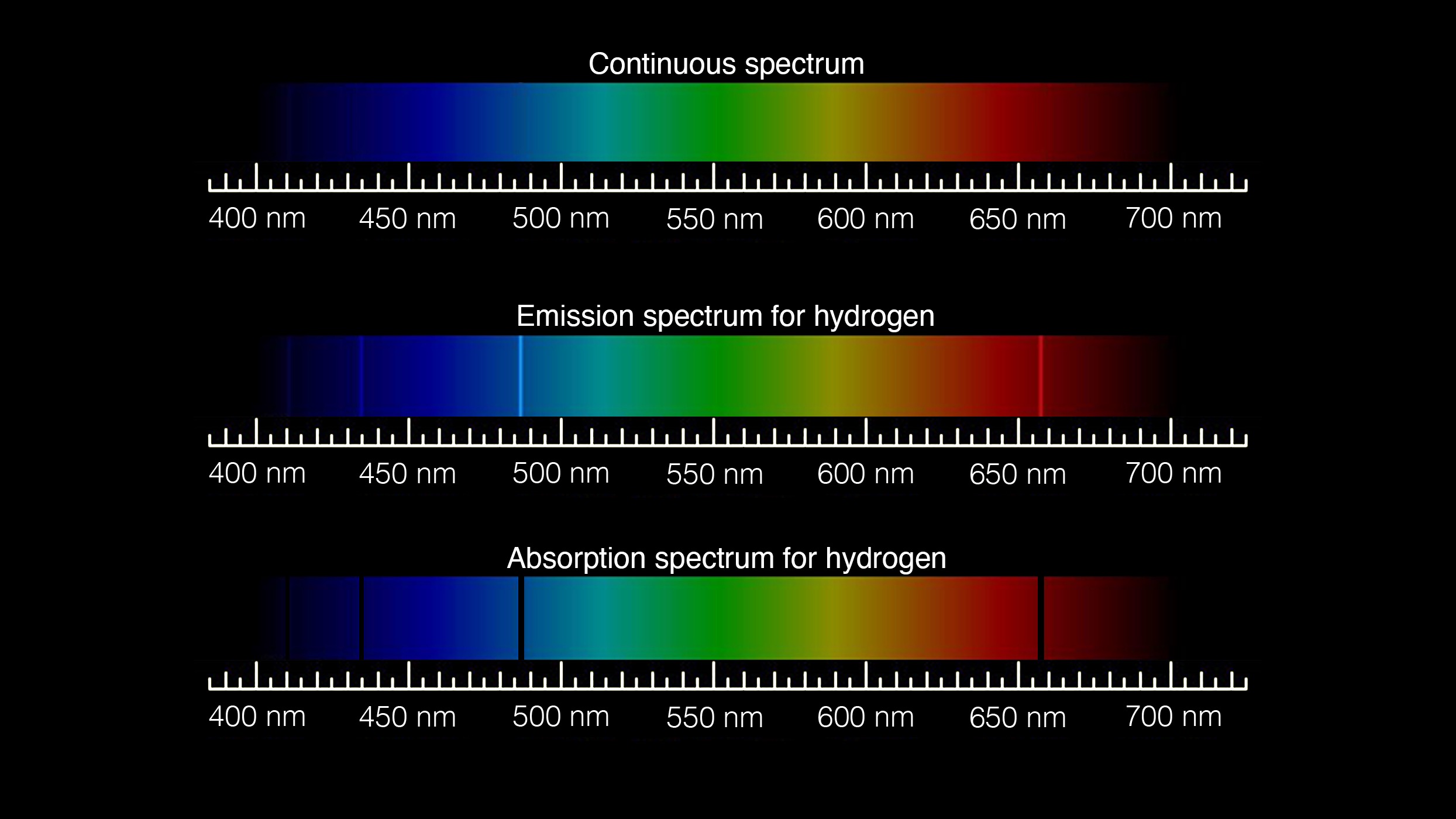
This graphic shows the divergence between a continuous spectrum and emission and absorption spectra for the element hydrogen. An emission spectrum shows bright lines at the wavelengths where light is emitted from atoms and molecules in a hot gas. An assimilation spectrum shows dark lines at the wavelengths where low-cal is absorbed when passing through gaseous elements in a star'south atmosphere. Prototype credit: NASA/JPL-Caltech | + Expand image
Shut examination of the visible-low-cal spectrum from our Sunday and other stars reveals spectral lines that deed similar fingerprints for atoms and molecules. Identifying these patterns tells scientists what elements and molecules make up a star.
Unlike light leaving the Lord's day, which takes eight.v minutes to achieve Globe, light leaving distant stars and galaxies can take billions of years to attain our planet. Every bit they travel, the waves that make up the lite go stretched as the universe expands – something it'due south been doing since the Big Bang.
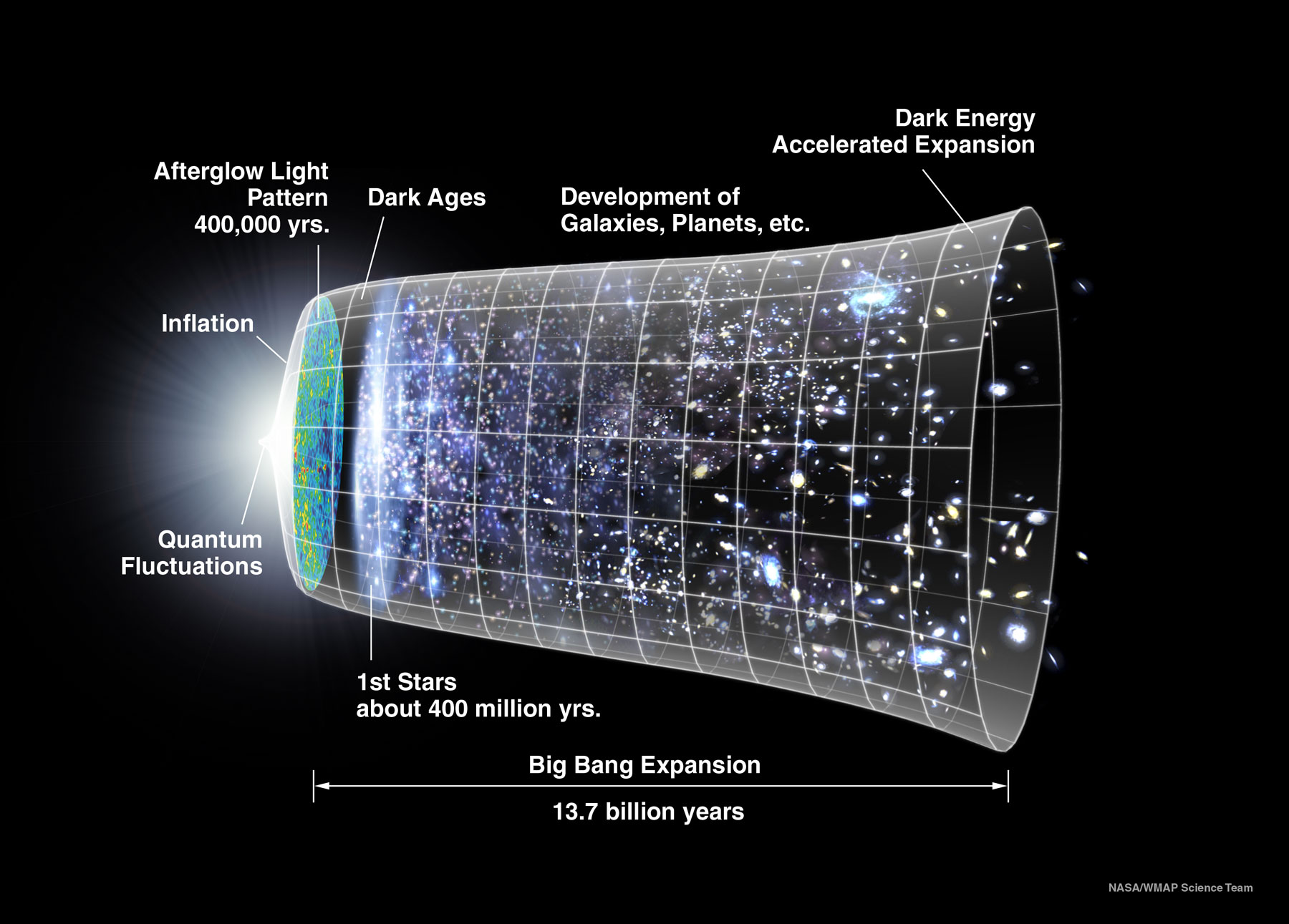
An illustrated timeline of the universe. Credit: WMAP | + Expand image
What this means for light coming from distant galaxies moving away from Earth as the universe expands is that the visible lightwaves yous would be able to come across with your eyes get stretched into longer wavelengths and shift from visible light toward infrared.
In the case of hydrogen, the four emission lines get shifted toward the redder (longer wavelength) end of the electromagnetic spectrum. Scientists refer to this phenomenon as redshift – and the farther abroad an object is, the more redshift it undergoes.
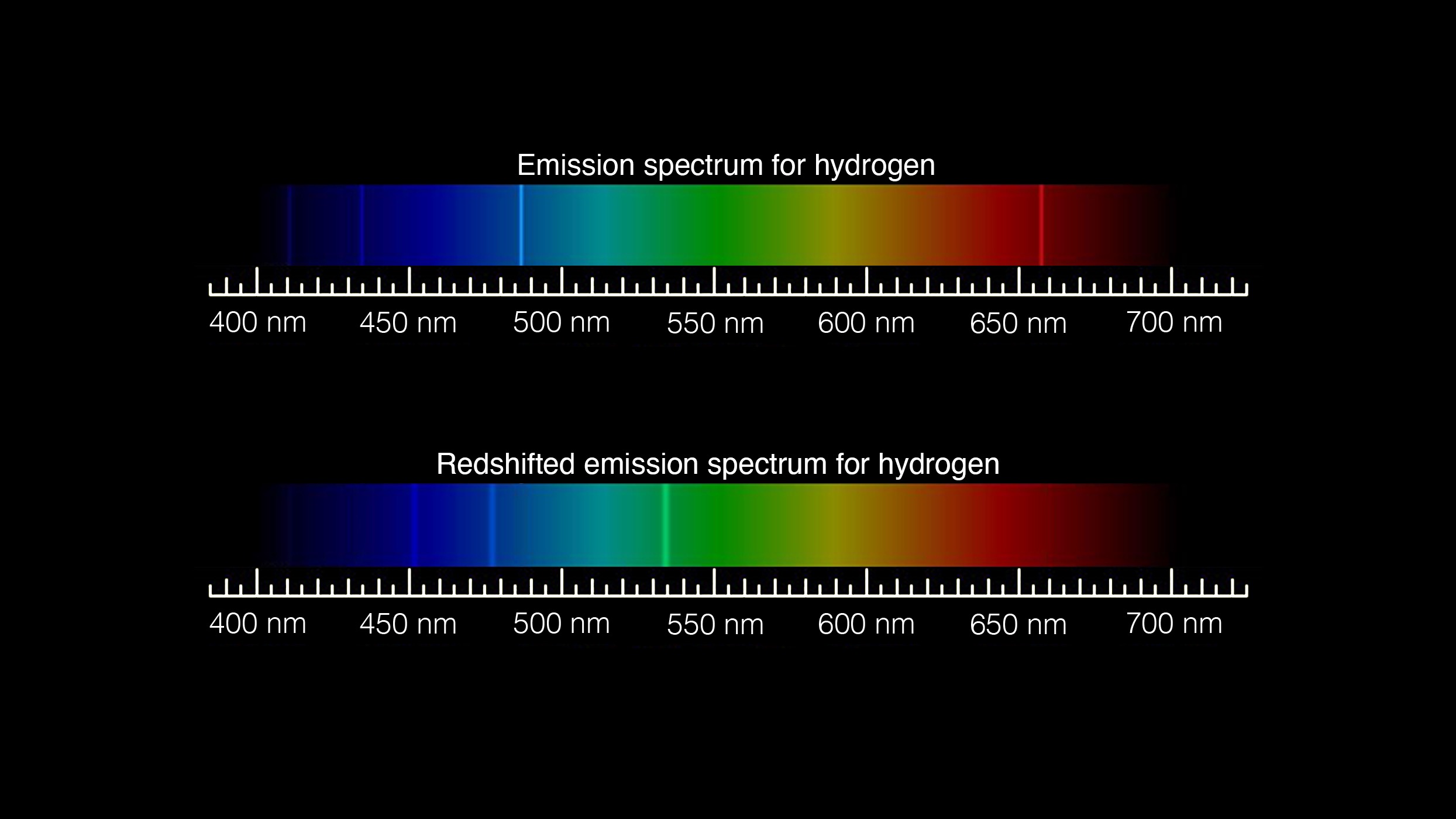
Detect how the vivid lines on the standard emission spectrum for hydrogen (superlative) take moved toward the red cease of the spectrum on the redshifted emission spectrum (bottom). Image credit: NASA/JPL-Caltech | + Aggrandize image
Calculating redshift
Redshift is given a value (z) and is calculated with the following equation:
z = (Wavelengtho - Wavelengthr) / Wavelengthr
z = redshift
Wavelengthr = the known wavelength of an chemical element non experiencing redshift
Wavelengtho = the observed wavelength of that emission line
By determining the redshift of an object, scientists can calculate the speed at which the object is moving away from us (as a result of the universe expanding) and the distance to the object from Earth.
Missions such equally the James Webb Infinite Telescope have advantage of this phenomenon by viewing light in the well-nigh- and mid-infrared wavelengths – the wavelengths to which calorie-free has shifted afterwards traveling from the virtually afar, and therefore oldest, stars and galaxies. This allows astronomers to peer into the early history of the universe.
Procedures
- Build or actuate students' groundwork knowledge by discussing the electromagnetic spectrum, different types of radiation, and wave properties.
- Explain to students the concept of the expanding universe. Print that infinite-time, the fabric of the universe itself, is expanding – information technology'southward not merely that objects within the universe are moving apart. Consider using the analogy of a loaf of raisin bread expanding every bit it bakes, with the dough representing infinite-time and the raisins representing galaxies or galaxy clusters.
Alternatively, describe several dots on a balloon with a felt pen. Explicate to students that the balloon represents space-time, and the dots represent galaxies or galaxy clusters. Ask them to predict what will occur when the balloon inflates. (As the balloon expands, the distance betwixt the dots will expand besides.)
- Complete one or both of the modeling and calculating sections with students. If completing some or all of the calculations, students should complete them in gild.
Model redshift
Either every bit a class demonstration or in groups of 2-3 students, use elastic bands as follows to model the expansion of spacetime and the stretching of visible low-cal into the infrared.
- Take students use a felt pen and a ruler to mark evenly spaced dots on the elastic to represent the crest of a visible light wave. Have students make note of how far autonomously their dots are.For added complexity, tell students that for this model, 1 millimeter on the elastic represents 100 nm and to place their dots five or vi mm autonomously from each other. Ask students to identify the colour in the visible spectrum that their wavelength represents.
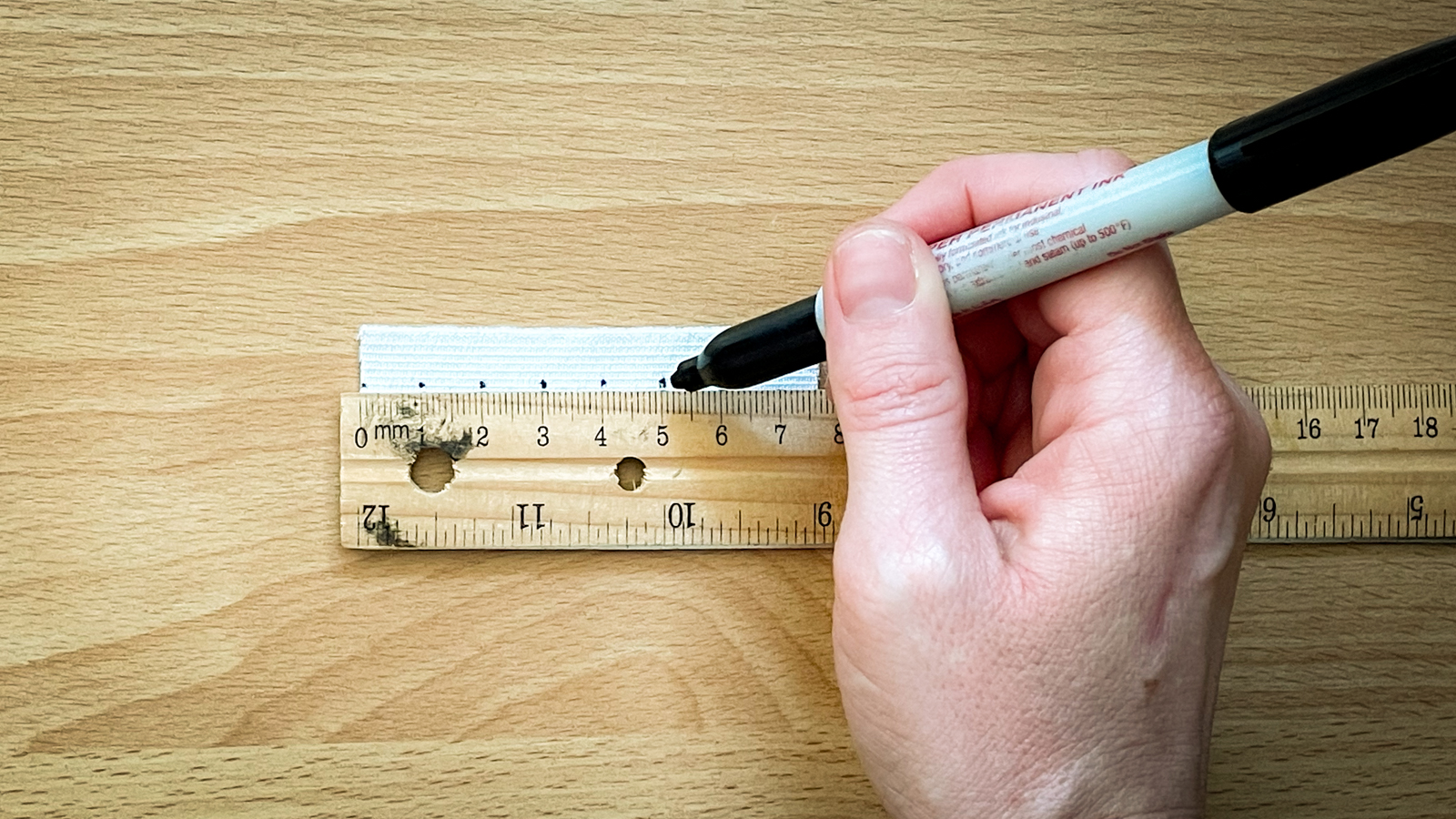
Describe evenly spaced dots on a strip of elastic. Prototype credit: NASA/JPL-Caltech | + Aggrandize epitome
In either case, if needed for students to visualize a wave, they tin describe in the rest of the moving ridge blueprint on the elastic.
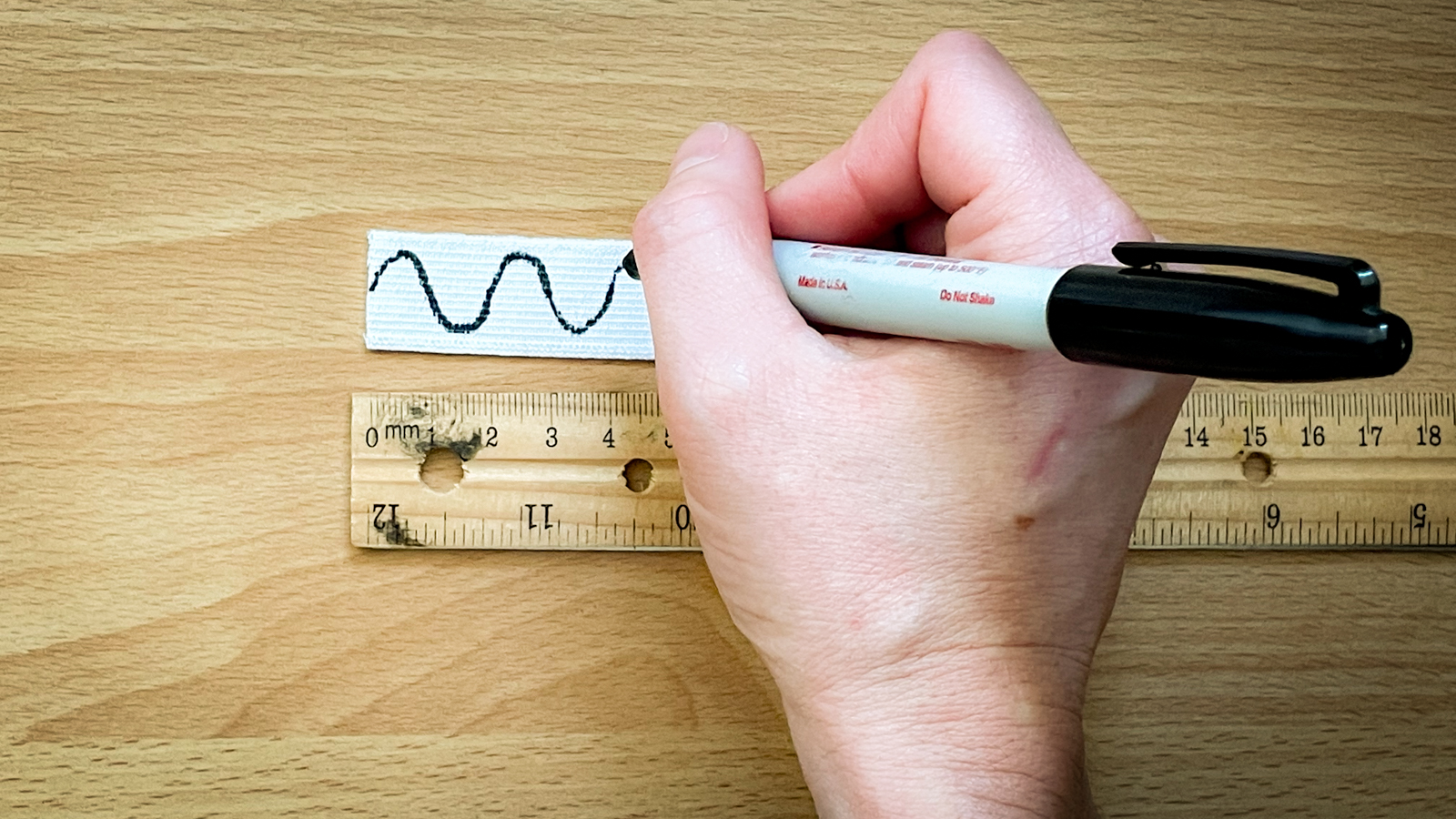
Optionally, describe wave segments connecting the dots. Epitome credit: NASA/JPL-Caltech | + Aggrandize image
- Have one student slowly stretch the elastic and hold it at its stretched length. Students can opt to stretch their elastic as far as information technology volition go, or merely stretch information technology a small corporeality. With the rubberband stretched, another student should mensurate the distance betwixt the dots (or wave crests) and record the distance.

The wavelength fatigued on the piece of rubberband gets longer every bit the elastic is stretched. Prototype credit: NASA/JPL-Caltech | + Expand paradigm
- Groups should identify that the distance between the dots or crests increased.
If students used the scale measurements and identified the light color in Step 1, they should at present convert their elastic measurements to scaled nanometer measurements and identify where on the electromagnetic spectrum their stretched wave is located.
Calculate redshift
Students will use the redshift equation, emission spectrum of hydrogen, and spectra from supernova iPTF15th to summate the redshift of the supernova.
- Introduce students to the equation used to calculate redshift:
z = (Wavelengtho - Wavelengthr) / Wavelengthr
z = redshift
Wavelengthr = the known wavelength of an element non experiencing redshift
Wavelengtho = the observed wavelength of that emission lineExplain that by calculating the redshift value students volition be able to determine the velocity at which an object is moving away from Earth equally a result of the expansion of the milky way. With that data, they can then determine the distance to that object.
- Have students calculate the redshift for i of the emission lines below, and so compare the results equally a class.Location of hydrogen spectral lines at rest:
Line i: 410.2 nm
Line 2: 434.0 nm
Line 3: 486.1 nm
Line 4: 656.3 nmLocation of hydrogen spectral lines observed in spectrum from supernova iPTF15th:
Line 1: 4511.91 Å
Line 2: 4773.69 Å
Line 3: 5347.64 Å
Line 4: 7219.33 ÅAnswers:
Line 1: z = 0.09993
Line 2: z = 0.0999
Line 3: z = 0.1001
Line iv: z = 0.1000 - Next, have them find the average redshift value for all four lines.
Answer: Average z = 0.1
Summate velocity
Students will use the Doppler shift formula to find the velocity of supernova iPTF15th away from Earth.
- Introduce students to the Doppler shift formula:
((wavelengtho - wavelengthr)/wavelengthr) = 5/c
five = velocity
c = the speed of light in a vacuum (3 x xeight thou/sec) - Have students use the Doppler shift formula to find the velocity of supernova iPTF15th away from Globe. If necessary, remind students that half of this equation was solved in the previous step when finding the average z value.
Answer: 0.ane * c = v => v = three 10 107 m/sec
Calculate distance
Students volition use Hubble's Law to observe the distance to supernova iPTF15th.
- Introduce students to Hubble'due south Constabulary, which is the observation that galaxies are moving away from Globe at speeds proportional to their distance (d) and is expressed as:
5 = H0 * d
5 = velocity
H0 = the Hubble constant of approximately 70 km/sec/Megaparsec
d = distanceNotation: A parsec is a unit of distance equal to approximately iii.26 low-cal years, and a Megaparsec is equal to one 1000000 parsecs.
- Have students use Hubble's Police force to discover the distance to supernova iPTF15th.
Answer: One Megaparsec (Mpc) = 3.26 * 10vi light twelvemonth.
iii * 107 g/southward = seventy km/s/Mpc * d
d = iii * x7 m/south / 7 * 10iv chiliad/s/Mpc
d ≈ 429 Mpc
429 Mpc ≈ one.4 x xix calorie-free years
Word
- What implications does redshift take for making observations of the most distant stars and galaxies, where even ultraviolet light may accept redshifted beyond the visible spectrum?
- If light has been traveling from a star, supernova or galaxy for one billion years, does that mean the object is currently one billion light years abroad?
Answer: The object would exist farther abroad since the universe is expanding and the object has moved abroad from Earth during the time the light has been traveling toward Earth.
- Do you think all objects in the universe are redshifted?
Answer: As the universe expands galaxy clusters and other distant objects are moving autonomously from each other, displaying redshift. All the same, nearby objects, such as planets, and even local galaxies, are gravitationally jump and not displaying redshift every bit a effect of the milky way expanding. In fact, the Milky way and the Andromeda galaxies are moving toward each other.
- What would you expect to see if the universe was contracting rather than expanding?
Answer: Students would wait to meet blue shifted wavelengths, every bit the light traveling toward the observer on Earth was compressed into shorter wavelengths as the space it was traveling through contracted.
Assessment
- Students should correctly measure a longer wavelength on the stretched rubberband.
- Students should calculate the correct z, v and d values in the problem set.
Extensions
Source: https://www.jpl.nasa.gov/edu/teach/activity/math-of-the-expanding-universe/
0 Response to "if the universe were contracting what would happen to light from other galaxies as it reaches earth"
Post a Comment